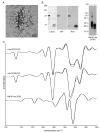Prion protein misfolding and disease
- PMID: 19157856
- PMCID: PMC2674794
- DOI: 10.1016/j.sbi.2008.12.007
Prion protein misfolding and disease
Abstract
Transmissible spongiform encephalopathies (TSEs or prion diseases) are a rare group of invariably fatal neurodegenerative disorders that affect humans and other mammals. TSEs are protein misfolding diseases that involve the accumulation of an abnormally aggregated form of the normal host prion protein (PrP). They are unique among protein misfolding disorders in that they are transmissible and have different strains of infectious agents that are associated with unique phenotypes in vivo. A wealth of biological and biophysical evidence now suggests that the molecular basis for prion diseases may be encoded by protein conformation. The purpose of this review is to provide an overview of the existing structural information for PrP within the context of what is known about the biology of prion disease.
Figures



References
-
- Priola SA, Vorberg I. Molecular aspects of disease pathogenesis in the transmissible spongiform encephalopathies. Mol Biotechnol. 2006;33:71–88. - PubMed
-
- Castilla J, Saa P, Hetz C, Soto C. In vitro generation of infectious scrapie prions. Cell. 2005;121:195–206. The first demonstration that infectious prion particles could be generated in vitro by mixing uninfected and prion-infected brain homogenates in serial rounds of dilution and sonication. This method is now widely termed protein misfolding cyclic amplification, or PMCA. - PubMed
-
- Deleault NR, Harris BT, Rees JR, Supattapone S. Formation of native prions from minimal components in vitro. Proc Natl Acad Sci USA. 2007;104:9741–9746. Demonstrated that prions could be formed without infectious PrP-res as a seed from a minimal set of components including native PrP-sen, lipid molecules, and a synthetic polyanion. - PMC - PubMed
-
- Riek R, Hornemann S, Wider G, Billeter M, Glockshuber R, Wuthrich K. NMR structure of the mouse prion protein domain PrP(121–231) Nature. 1996;382:180–182. First NMR solution structure of the globular fold of PrP-sen. - PubMed
Publication types
MeSH terms
Substances
Grants and funding
LinkOut - more resources
Full Text Sources
Research Materials

